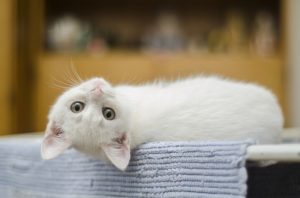
Trying to understand your new pet or the neighbor’s? Here are some common sounds cats make.
Communication is key. This motto applies in all kinds of circumstances, including your relationship with your pet cat! Cat owners can take better care of and relate to their feline friends much better when they can listen and understand. In a previous post, we covered some common cat body language signals and what they mean. In this post, we’ll be discussing the most common cat sounds.
Meow
The meow is the quintessential cat sound, but did you realize it can come in many different forms? Meows can be high, mid, or low pitched and shorter or longer. Kittens often meow to communicate with their mother, but in adulthood, their meows often indicate that they want something from humans. Their inflection often gives away their meaning, sometimes indicating a welcome, an objection, or even illness or loneliness.
Chirp
Some cats will “chirrup” instead of meow. Chirps and trills are often a declaration of something important or a sign of happiness. It could be that your cat is happy to see you or wants to bring something to your attention.
Purr
Purring is a classic cat sound and is well-known as a sign of contentment and happiness. A cat will often purr if it is feeling comfortable, such as when you are petting it. However, it can also be a sign of distress or nervousness. If that is the case, you will likely see body language that accompanies that nervousness, such as drawn-back ears and wide eyes.
Hiss
The hiss is an unmistakably negative cat sound, but does it mean more than simply, “Back away?” If your cat feels provoked or threatened, it will naturally hiss to fend off the offender. If the hissing is unprovoked, it could be a sign of pain.
Yowl
A cat yowl is a prolonged, loud sound similar to a moan. It can signify that your cat is looking for a mate, especially if it is not spayed or neutered. It can also indicate worry, upsetness, boredom, or pain. A cat that has moved house might yowl due to its lost territory. On the other hand, if you believe your cat might be in pain, contact Everhart Veterinary Medicine in Baltimore, MD!
Trust the Care of Your Pet to the Professionals at Everhart Veterinary Medicine!
At Everhart Veterinary Medicine, our veterinary professionals strive to provide your pet with the very best of veterinary care. We believe that the best care for your pet should be provided by experienced, compassionate, and knowledgeable veterinary professionals. With two Maryland locations in both Baltimore and Pasadena, we are always ready to welcome your pet as a new patient! Give us a call today at 410-355-3131 or 410-793-7670! For more information, as well as updates on veterinary news and topics, visit us on Facebook, Twitter, or LinkedIn!
